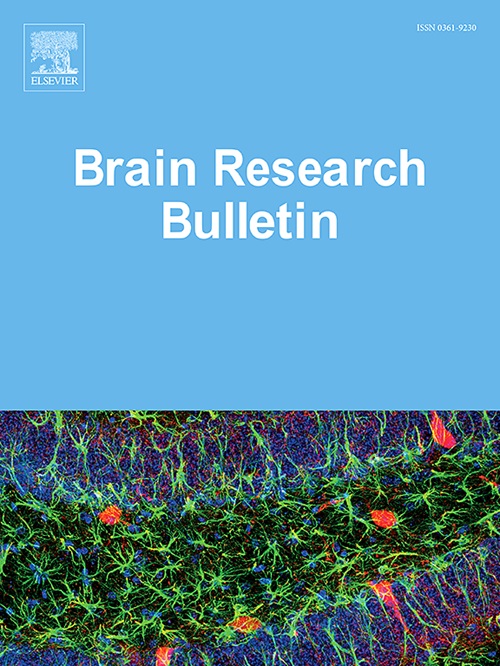催产素可以改善早期生活过度屏幕时间暴露的大鼠模型中的社交缺陷和大脑发育障碍
IF 3.7
3区 医学
Q2 NEUROSCIENCES
引用次数: 0
摘要
近年来的研究表明,生命早期过多的屏幕时间可能会显著促进社会缺陷和自闭症样行为的出现。然而,确切的潜在机制和最佳治疗策略尚不完全清楚,之前的研究结果相互矛盾。本研究以早期过度屏幕暴露大鼠为研究对象,探讨了催产素对过度视听刺激(EAVS)诱导的自闭症相关行为及相关脑结构异常的影响。从出生后第12天(PND)到第35天(PND),新生大鼠幼仔暴露于EAVS,并在PND21至PND35期间给予0.8 IU/kg剂量的鼻内催产素(OXT)。行为评估包括社会互动、重复行为、运动活动和焦虑样行为,以及三维大脑结构测量,在青春期进行(PND50-PND55)。结果显示,在催产素的调节下,EAVS组大鼠的社交活动异常,多动症,杏仁核和前扣带皮层(ACC)等脑区体积和神经元数量发生变化。我们的研究结果表明,OXT可以减轻早年过度接触数字屏幕的不良影响,通过调节大脑可塑性来增强社会偏好。观察到的神经解剖学和行为改变强调了发育中的大脑对早期过度屏幕暴露的脆弱性,并提出了通过OXT解决由EAVS引起的社会障碍的潜在治疗途径。本文章由计算机程序翻译,如有差异,请以英文原文为准。
Oxytocin can ameliorate social deficits and brain developmental impairments in a rat model of early life excessive screen time exposure
In recent years studies have shown that early life excessive screen time exposure may significantly contribute to the emergence of social deficits and autistic-like behaviors. However, the exact underlying mechanisms and the optimal treatment strategies are not completely understood, with conflicting results of preceding findings. This study investigates the effect of oxytocin on autism-related behaviors, and associated brain structure abnormalities induced by excessive audiovisual stimulation (EAVS) as an early life excessive screen exposure model in rats. Neonatal rat pups were exposed to EAVS from postnatal day (PND) 12 to PND 35, and intranasal oxytocin (OXT) at a dose of 0.8 IU/kg was administrated from PND21 to PND35. Behavioral assessment including social interaction, repetitive behavior, locomotor activity, and anxiety-like behavior, along with three-dimensional brain structure measurements were done during adolescence (PND50-PND55). The results revealed EAVS-induced anomalies in social interaction, hyperactivity, and changes in the volume, and neuron number of brain regions including the amygdala and anterior cingulate cortex (ACC) in the EAVS group which were modulated by oxytocin. Our findings suggest that OXT may mitigate adverse effects of early life excessive exposure to digital screens, enhancing social preferences through modulating brain plasticity. The observed neuroanatomical and behavioral alterations highlight the vulnerability of the developing brain to early life excessive screen exposure and suggest a potential therapeutic path through OXT to tackle social impairments induced by EAVS.
求助全文
通过发布文献求助,成功后即可免费获取论文全文。
去求助
来源期刊

Brain Research Bulletin
医学-神经科学
CiteScore
6.90
自引率
2.60%
发文量
253
审稿时长
67 days
期刊介绍:
The Brain Research Bulletin (BRB) aims to publish novel work that advances our knowledge of molecular and cellular mechanisms that underlie neural network properties associated with behavior, cognition and other brain functions during neurodevelopment and in the adult. Although clinical research is out of the Journal''s scope, the BRB also aims to publish translation research that provides insight into biological mechanisms and processes associated with neurodegeneration mechanisms, neurological diseases and neuropsychiatric disorders. The Journal is especially interested in research using novel methodologies, such as optogenetics, multielectrode array recordings and life imaging in wild-type and genetically-modified animal models, with the goal to advance our understanding of how neurons, glia and networks function in vivo.
 求助内容:
求助内容: 应助结果提醒方式:
应助结果提醒方式:


